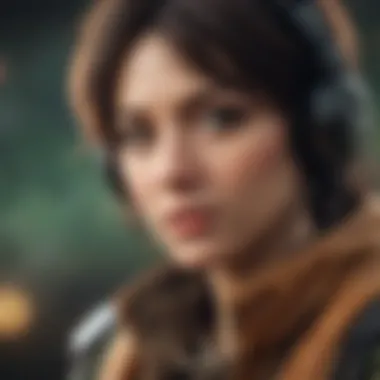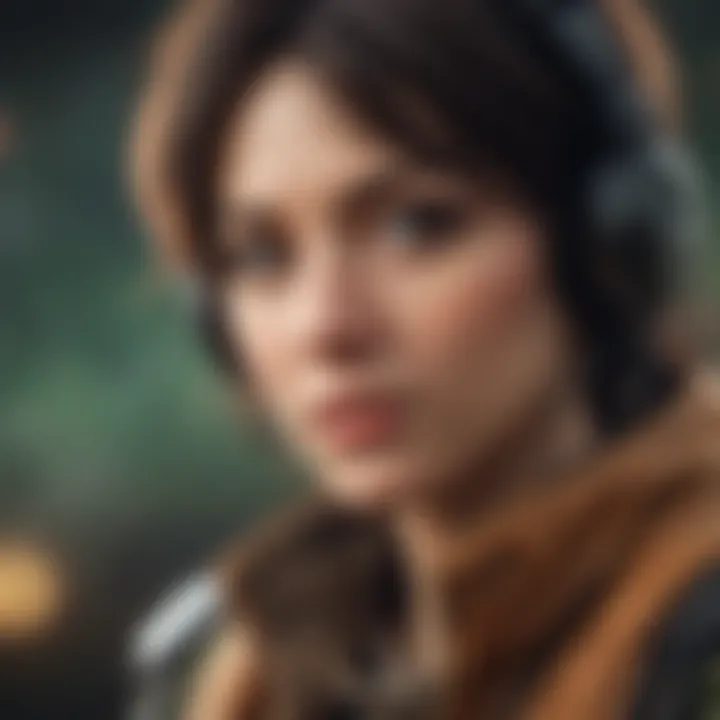Exploring the Depths of AOT Dubbed Episodes


Intro
The world of Attack on Titan (AOT) is a landscape marked by intense drama, gripping narrative arcs, and intricate character designs. AOT, which has become a staple in the anime community, portrays a dystopian world where humanity struggles to survive against colossal humanoid beings known as Titans. As the popularity of this series surged, so did interest in its dubbed episodes. Delving into these adaptations reveals not only the mechanics of voice acting and cultural translations but also the diverse reactions from fans across the globe.
In this exploration, we will dissect various facets of AOT's dubbed episodes, providing clarity on how the translation and performance of voice actors affect the overall viewing experience. In a field where nuance is key, understanding the subtleties involved in these productions can shed light on broader discussions about localization and audience preference in global media.
Overview of Attack on Titan
Attack on Titan originally premiered as a manga, penned by Hajime Isayama, before being adapted into an anime series. The story unfolds in a world besieged by Titans, forcing the remaining population to take refuge behind massive walls. With themes of survival, betrayal, and the questioning of humanity, the plot strikes a chord with viewers, making it a standout in contemporary anime. The dubbed versions, produced largely for audiences outside Japan, offer a different lens through which to experience the series.
The Dubbing Process
The process of dubbing is far from straightforward. It involves not only translating dialogue but also reinterpreting emotions, pacing, and cultural references. Each language has its own unique quirks, and where one phrase might roll off the tongue effortlessly in Japanese, it may become cumbersome in English or other languages. Voice actors must capture the essence of the original performances while making the characters relatable to their new audience.
To summarize the dubbing challenges:
- Language Nuance: Idiomatic expressions often do not translate well.
- Cultural References: Certain elements may require alteration or explanation for non-Japanese viewers.
- Emotional Authenticity: Retaining the original tone while ensuring clarity in the new language presents a constant challenge.
The art of dubbing blends linguistic skill with performance, creating a new avenue for storytelling.
Reception and Impact on Audiance
When dubbed versions are released, reactions can be quite polarized. Fans often express strong preferences for either subbed or dubbed formats. Some argue that the original voice performances convey more authenticity, while others appreciate the accessibility of dubbed versions.
- Pros of Dubbed Episodes:
- Cons of Dubbed Episodes:
- Wider accessibility for those unfamiliar with reading subtitles.
- The opportunity for international fans to engage with the material without the barrier of written language.
- Potential loss of cultural depth or original intent.
- Differences in voice character interpretation may not resonate the same way.
In analyzing the reception, it's clear that cultural backgrounds, personal preferences, and individual viewing experiences play significant roles in how dubbed episodes are appreciated. Ultimately, they facilitate greater dialogue about the nuances of anime localization and consumer expectations, showcasing an evolving international audience.
In the subsequent sections, we will delve into the key aspects of character development and the visual elements that shape the viewing experience of Attack on Titan, providing a holistic view of what makes this series both captivating and strategically relevant in today's anime landscape.
Prelude to AOT
When we talk about Attack on Titan, often referred to as AOT, we are diving deep into a phenomenon that encompasses much more than just a storyline. It’s a cultural juggernaut that resonates worldwide, sparking discussions around themes of freedom, survival, and what it means to be human in dire situations. The dubbed episodes make this narrative accessible to a broader audience, turning the anime into a shared experience for those who might struggle with the complexities of reading subtitles.
Overview of Attack on Titan's Narrative
At its core, Attack on Titan follows the struggle of humanity against the monstrous Titans. Set in a world where humans reside within enormous walled cities to protect themselves, the plot begins with the sudden appearance of these giants, throwing society into chaos. The series tackles heavy themes such as betrayal, revenge, and the moral ambiguities of war. Characters like Eren Yeager and Mikasa Ackerman, who are reluctant heroes, navigate through their personal traumas while attempting to uncover the truth behind their world.
One might say that AOT serves as a mirror reflecting our own societal issues, albeit through the lens of fantasy. The intricate narrative structure encapsulates the emotional highs and lows, offering viewers not just entertainment but also thoughtful commentary on personal and broader societal dynamics.
Cultural Significance of AOT
The significance of Attack on Titan extends beyond its immediate plot and character arcs; it challenges cultural norms and perceptions. The series questions established authority and examines the role of power in human interactions. Such themes resonate particularly well within communities that have experienced oppression or societal constraints.
Moreover, AOT has influenced various aspects of popular culture. From memes to cosplay, the series has left an indelible mark. Its motifs have sparked discussions around contentious topics, making it a touchstone for fans and critics alike.
- Cultural Reflection: The series reflects global anxieties, making it relatable regardless of geographical boundaries.
- Influence on Other Media: Inspired by the success of AOT, many creators seek to explore similar themes, contributing to a richer narrative landscape in anime and beyond.


Thus, the importance of the Introduction to AOT in this article is multifaceted. Recognizing the narrative and cultural depth of Attack on Titan sets the stage for a more intricate understanding of its dubbed episodes, offering insights not only into production elements but also into how they resonate within a global context.
The Process of Dubbing Anime
The process of dubbing anime serves as a significant cornerstone in making works like Attack on Titan accessible to a broader audience. The art of dubbing not only bridges language gaps but also ensures that the emotional heft of the original dialogues is imparted effectively. This careful transition enhances the viewing experience, allowing non-Japanese speakers to engage with the gripping narratives and complex themes without losing the nuanced storytelling that anime is celebrated for.
Dubbing enables viewers to appreciate the aesthetic and cultural intricacies of series like AOT without getting bogged down by the need to read subtitles. This often leads to a more immersive experience, allowing fans to fully absorb visual details while savoring impactful character interactions and plot developments. However, the process is not without its challenges, as maintaining the original tone and intent of the creators requires a delicate balance of translation and performance.
Steps Involved in Dubbing
Dubbing comprises several meticulous stages, each paramount to achieving a polished final product. Here’s a breakdown of the primary steps involved:
- Script Adaptation
First and foremost, the original script is adapted for the target language. This involves not just translation, but also cultural contextualization to match phrases, idioms, and the spirit of the source material. - Casting Voice Actors
Selecting voice actors who can capture the essence of the characters is crucial. Each voice should resonate with the personality and emotional journey of the respective role. - Recording
Actors record their lines in a sound studio, usually guided by a director who ensures that performances align with the original content’s tone. - Post-Production
Sounds, effects, and music are then blended, ensuring that the final audio complements the visual aspects seamlessly. Sound engineers play a vital role in this procedure. - Final Review
Finally, the dubbed version goes through quality checks to ensure that it meets the required standards before release. Here, feedback is often gathered, leading to necessary adjustments.
Each step in this process intricately weaves together, underscoring the collaborative efforts needed to present a cohesive dubbed anime. It’s akin to a fine tapestry; pull at one thread, and you risk unraveling the entire piece.
Translation and Localization Strategies
When it comes to the translation of AOT, the goal is much more than mere word-for-word conversion. Localization plays a critical role in adapting dialogues to feel natural for the audience. Translators must consider cultural references, humor, and even the context of certain scenes. A line delivered in a certain way in Japanese might land flat in English unless it's cleverly adapted.
"The art of localization is like seasoning in a recipe – it can make or break the dish."
For example, terms used by characters may invoke specific emotions or cultural sentiments. The translators must find equivalent expressions that evoke similar feelings in the target language. Sometimes, this involves creating new lines that retain the original meaning but are entirely different in structure. Additionally, attention to character voice and personality is paramount, as it impacts how audiences connect with each character.
Technology in Dubbing
The technological advancements in dubbing have been remarkable. From high-quality recording equipment to sophisticated editing software, the tools available to dubbing studios have transformed the industry's landscape. Notably, digital audio workstations (DAWs) have streamlined the recording and editing processes, enabling smoother workflows.
Moreover, the integration of artificial intelligence and machine learning is beginning to make waves in dubbing practices. These technologies can help analyze patterns in dialogues, suggesting alternate translations or edits. However, while these innovations increase efficiency, they must be used carefully to avoid losing the rich nuances that define anime.
Voice Acting in AOT Dubbed Episodes
Voice acting holds tremendous weight in the realm of anime dubbing, particularly for a series as complex and emotionally charged as Attack on Titan. The voice actors are not merely voices behind the characters; they are the very soul that breathes life into the narrative. Their ability to convey the emotional intensity of each scene is critical. Missteps in performance can lead to a complete disconnect between the audience and the story.
Each voice actor’s interpretation plays a vital role in shaping the viewer’s experience. When fans hear a character’s voice, it's not just sound; it's a deep connection to that character’s journey and struggles. Thus, selecting the right voice actors to match the essence of the original characters is something that cannot be taken lightly. This practice enhances not only the viewing experience but also the emotional resonance of Attack on Titan, engaging the audience in a unique way.
By giving distinct personalities to the characters, voice actors enrich the narrative, making it more relatable. The blending of their vocal style with the animation helps in building a world that feels genuine and immersive.
Role of Voice Actors
Voice actors are the unsung heroes of the dubbing process. They contribute to establishing a character’s personality through vocal intonation, emotional delivery, and subtle inflections. Take, for instance, the character Eren Yeager. The voice actor's approach to his anger, frustration, and determination is crucial in portraying his character’s complex journey throughout the series.
Unlike traditional acting where body language and facial expressions can convey emotions, voice acting relies solely on vocal cues. Thus, each performance demands not just talent but also a keen understanding of the character’s arc. The voice actor must become that character, leaving behind their individuality to inhabit the role fully. This transformation is fundamental; it creates a character that fans can either rally behind or oppose passionately.
Challenges Faced by Voice Actors
Dubbing presents its own set of hurdles for voice actors. Firstly, there's the challenge of timing. The lines must sync with the lip movements of the characters on-screen, which can often lead to strenuous playback attempts to get the timing just right. Moreover, maintaining the emotional weight of the original performance while matching the rhythm and pacing can become a tightrope walk.
Another significant challenge is the cultural nuances embedded within dialogue. Voice actors might discover that certain phrases or idioms do not translate directly in a way that captures the original intent. This necessitates improvisation and critical thinking to find alternative expressions that evoke the same sentiment in the target language. For example, conveying the sense of urgency during a battle scene might involve adjusting the tone or speed, which goes beyond mere translation.
Comparative Analysis of Sub vs. Dub


The perennial debate between subbed and dubbed anime often hinges on the perceived authenticity of the viewer’s experience. Sub aficionados argue that hearing the original Japanese voice actors retain the intended emotion and cultural nuances. On the contrary, proponents of dubbed versions often appreciate the accessibility and engagement of being able to focus entirely on the visuals rather than reading subtitles.
Moreover, it is pertinent to consider how a well-executed dub can elevate a series. For Attack on Titan, the English dubbed version showcases top-tier voice talent that has reimagined the characters, providing an alternate angle to their personalities.
Audience Reception of AOT Dubbed Episodes
Understanding audience reception of the dubbed episodes of Attack on Titan offers profound insights into how adaptations influence viewer engagement. The way fans perceive dubbed content matters not just for the show’s success, but also speaks to broader trends in anime localization. As dubbing strives to balance fidelity to the original material while making it accessible to a different language group, audience reactions can reveal the nuances of cultural adaptation.
Fan Preferences: Dub vs. Sub
In the ongoing debate between dubbed and subtitled versions of anime, preferences often fall into a personal battleground shaped by individual experiences. For some, watching a dubbed episode provides a streamlined viewing experience. This allows them to immerse themselves in the visuals rather than focusing on reading subtitles. For example, fans with busy lifestyles may prefer the dub as it demands less from their multitasking brains.
Conversely, purists argue that subtitles capture the emotional depth of the original voice acting, often lost in translation. Numerous discussions on platforms like reddit.com showcase heated exchanges about these preferences. It’s not uncommon to see avid supporters of subtitled versions citing moments where character emotions were either heightened or diluted in dubbing. Some viewers believe the original Japanese voice actors convey subtleties that the English cast might overlook, possibly due to cultural differences in delivery.
Ultimately, it’s crucial to acknowledge that both formats serve their unique audience segments. The availability of both options ensures that fans can engage with the content in the way they feel is most authentic, promoting a richer community dialogue.
Impact of Cultural Elements on Reception
Cultural nuances play a pivotal role in how dubbed episodes are perceived. Localizing dialogue is not simply about direct translation; it's about adapting cultural references and humor so they resonate with the target audience. In Attack on Titan, elements such as military references and symbolic representations of freedom often require careful consideration in the dubbed version. If left unaddressed, these subtleties could either confuse or alienate viewers.
For instance, a phrase that sounds perfectly normal in Japanese might evoke different connotations in English. Thus, localization teams often find themselves at a crossroads. Should they stick to a literal translation or would a more colloquial approach better serve the audience’s understanding? The choice can significantly affect the reception.
Also, many fans resonate more deeply with characters who reflect their own cultural backgrounds, which can be a double-edged sword. Dubbing houses must create characters that feel relatable to an English-speaking audience while maintaining the essence of their Japanese counterparts.
"Localization can significantly change how a story is experienced, and Attack on Titan is no exception to this rule."
This relationship between cultural context and audience reception emphasizes the importance of understanding the land beyond the language. While the dubbing may cater to an English audience's sensibilities, it's essential to not forget the original’s essence, which in turn enriches the viewer’s experience.
Critical Perspectives on Dubbing
Dubbing is often a contentious topic within the anime community, especially when it comes to series as popular as Attack on Titan. The importance of understanding critical perspectives on dubbing lies in various dimensions that shape viewers’ experiences and perceptions. Acknowledging the nuances within the realm of dubbing not only sheds light on the artistry involved but also highlights the socio-cultural implications that come along with these adaptations.
Analyses of Notable Reviews
When diving into the assessments made by critics and fans alike, one cannot ignore the varied viewpoints that surface around the dubbed episodes. Some reviews highlight the achievements in fidelity, where the dubbed voices resonate with the emotional weight carried by the original Japanese performances. For example, critics often celebrate Matthew Mercer’s portrayal of Levi Ackerman, noting how his voice delivers the calm intensity associated with the character.
However, not all feedback is sunshine and rainbows. Many fans express discontent with the tonal shifts that sometimes occur in the English adaptation. Reviews often reflect a dichotomy in preferences, with some audience members insisting that certain phrases, especially in intense action sequences, lose their punch in translation. Here's a brief look at some insights:
- Positive Aspects:
- Negative Aspects:
- Character voices align well with personalities.
- Emotional scenes receive solid interpretations.
- Localization may soften the original content’s impact.
- Dialogue alterations can create disconnects from the intended experience.
These contrasting observations underline the subjective nature of dubbing and how reviews serve as a window into the expectations and feelings of the anime audience.
Academic Discourse on Anime Dubbing
Exploring the academic lens also reveals enlightening discourse on anime dubbing. Scholars often focus on the intersection of translation studies and cultural interactions. For instance, one study might explore how localization reflects broader socio-political narratives. This can be particularly relevant for Attack on Titan, which carries complex themes like freedom and oppression.
The narratives of dubbing often circle back to the challenge of balancing a faithful adaptation with cultural resonance. Academics frequently critique how certain cultural references may skew or lose significance when translated. Additionally, they examine the impact of technological advances on dubbing practices.


Here are significant considerations in this discourse:
- Translation Techniques:
- Cultural Sensitivity:
- Interpretation vs. Direct Translation.
- Use of slang and idioms that may not translate well.
- Recognizing and adapting specific cultural values.
- Assessing audience reactions to localization choices.
Ultimately, this academic pursuit marries the practical aspect of voice acting with theoretical discussions, enriching the overall understanding of anime dubbing within the cultural tapestry.
"Dubbing is not merely about changing the voice; it’s a cultural negotiation that reveals the values and expectations of different audiences."
By taking a closer look at notable reviews and academic perspectives, one can uncover the complex layers that define the dubbing of Attack on Titan. These insights not only deepen the appreciation for the craft involved but also encourage constructive conversations among fans, creators, and scholars.
The Future of Dubbing in Anime
As we look down the barrel of an increasingly globalized world, the future of anime dubbing is brimming with complexity and potential. The way audiences consume content is evolving rapidly, and with this comes a demand for more authentic and culturally resonant adaptations. Anime fans are not just passive viewers anymore; they are active participants in the conversation regarding how their beloved shows are presented to them. This section will dissect significant elements transforming the dubbing landscape, the benefits of these transformations, and important considerations that both fans and producers must address moving forward.
Trends in Voice Acting
The voice acting scene in anime is shifting gears, embracing a wider array of talent and backgrounds. No longer are voice actors just delivering lines; they’re immersing themselves in the characters’ psyche. This is paramount for a series as layered as Attack on Titan, where emotional nuance can be the difference between a memorable performance and one that falls flat.
- Diversity in Casting: There's a growing movement towards more diverse voice actors who can bring a range of experiences and authenticity to their roles. This opens up a treasure trove of new interpretations of existing characters. For example, hiring actors with different cultural backgrounds can enrich the narrative depth.
- Increased Use of Technology: Tools like artificial intelligence are being utilized to train new voice talent. This is not just about replicating sounds but understanding emotional triggers and delivering a performance that aligns with the original intent.
"In the world of dubbing, the soul of a character is equally important as the lines they speak."
Technological Innovations Impacting Dubbing
Stepping into the future, technology is proving to be a double-edged sword. It has the power to streamline processes, making dubbing faster and more effective, but it also beckons questions about authenticity and emotional engagement.
- AI and Voice Synthesis: Sophisticated algorithms can now mimic human speech with startling accuracy. While this can help fill gaps or even dub entire shows more quickly, it begs the question: what happens to the human element of performance?
- Remote Collaboration: The pandemic introduced new dynamics in the workplace. Nowadays, audio engineers and voice actors from different corners of the globe can work together seamlessly, which aids in creating products that speak to more diverse audiences and cultural understandings.
- Improved Editing Software: Advanced software allows for better syncing of audio with animation. The values of pacing and timing can significantly impact the viewer's enjoyment, and such advancements are elevating this aspect of dubbing.
Potential Changes in Audience Expectations
Now, with the critical eye of fandom watching closely, audience expectations for dubbing are navigating a sea of change. Viewers want authenticity, cultural relevance, and an experience that resonates beyond mere entertainment.
- More Direct Engagement: Fans are now vocal on platforms like Reddit and social media about what they want in dub adaptations. This kind of access can pressure studios to listen and evolve their processes to meet growing demands.
- Cultural Sensitivity: As discussions around representation become more mainstream, audiences expect localizations that reflect this. They no longer settle for slapdash translations but desire careful adaptations that honor the original context of characters and storylines.
- Performance Quality: Viewers are recognizing and appreciating the nuances that skilled voice acting brings to a series. Every emotional beat in a show like Attack on Titan hinges on the voice acting. They want actors who can breathe life into the words, delivering a performance that can rival the most gripping live-action portrayals.
In summary, the realm of anime dubbing is on the brink of further evolution. With innovative technology and a forward-thinking approach to casting and cultural awareness, there is a palpable excitement for what is to come. For fans and creators alike, the journey promises to be as thrilling as the narratives they champion.
Closure
In the realm of anime, the significance of dubbing transcends mere translation; it's about capturing the soul of the work and redefining it for diverse audiences. This conclusion encapsulates the extensive journey we've undertaken through Attack on Titan (AOT) dubbed episodes. The importance of understanding these episodes cannot be overstated, as they provide a lens into the complexities of localization and the emotional depth embedded within the original narrative.
Summation of Key Insights
Throughout this article, several pivotal insights emerged regarding the dubbed episodes of Attack on Titan:
- Cultural Nuances: Dubbing is not just about the words spoken but also about reflecting cultural contexts. The voice talent and production teams strive to ensure that local audiences can relate to the characters and stories, making the experience feel genuine.
- Audience Preferences: There is a noticeable divide in fandom, with some leaning towards the subtitled versions due to their closeness to the original. Others find the dubs more accessible, particularly newer viewers. Understanding these varying preferences is crucial.
- Voice Acting Challenges: The voice actors face unique challenges, from capturing the intense emotions of a scene to matching the animation. The nuances in performance can greatly influence how well the dubbed episodes resonate with fans.
- Technological Impact: Advancements in audio and translation technologies have changed the landscape of anime dubbing, enhancing quality and accessibility, while also evolving audience expectations.
These insights form the foundation of how dub culture continues evolving, especially for a series as impactful as AOT.
Final Thoughts on AOT's Contribution to Dubbing Trends
Attack on Titan has undeniably set a benchmark in the anime dubbing sphere. Its success can be attributed to several factors:
- High-Caliber Voice Actors: The series features talented voice actors who bring the characters to life, allowing viewers to connect emotionally.
- Cohesive Storytelling: The systematic approach in adapting the narrative for different audiences has maintained the series' dramatic tension, making it resonate universally while respecting its Japanese roots.
- Engaging Fan Communities: Online platforms have emerged, with fans collectively discussing their preferences and experiences regarding subs and dubs, creating an enriching dialogue that informs future dubbing efforts.
In summary, Attack on Titan has not only contributed significantly to anime as a whole but has also shaped the expectations surrounding dubbed content in ways that may very well influence upcoming series. As we continue to navigate the expansive landscape of anime, the lessons drawn from AOT will remain pivotal in enriching the viewing experience for audiences around the globe.















